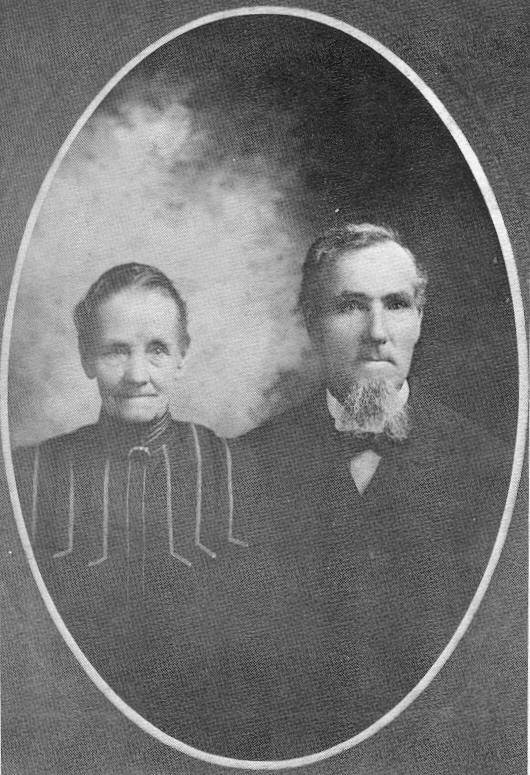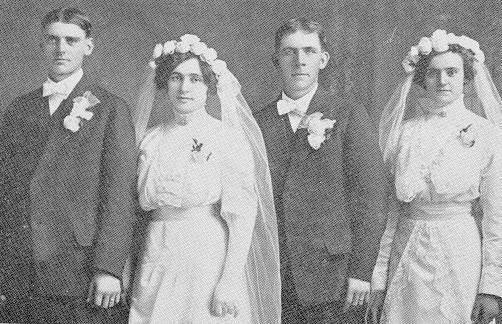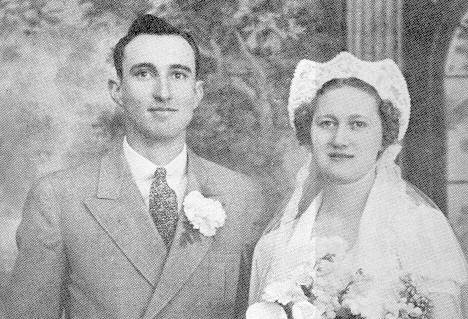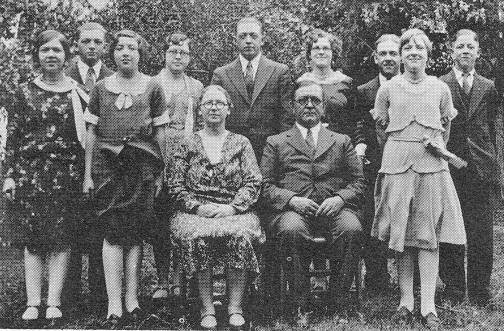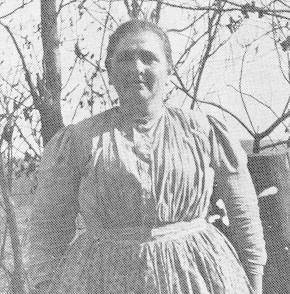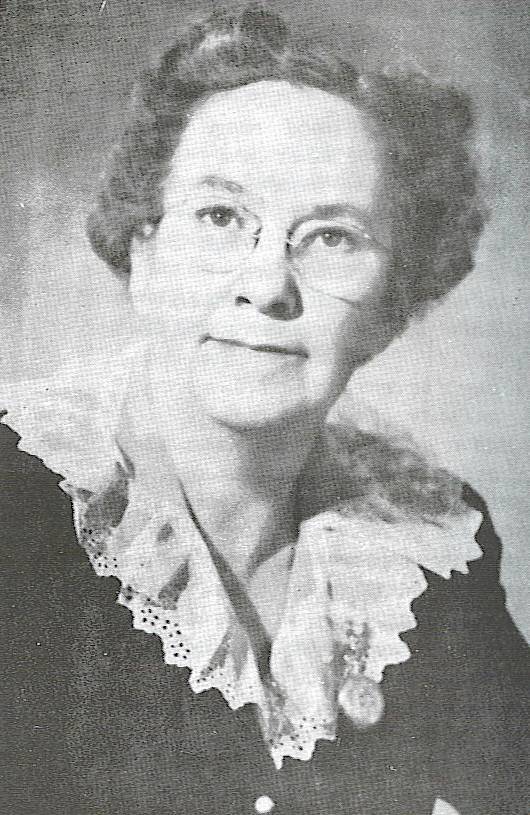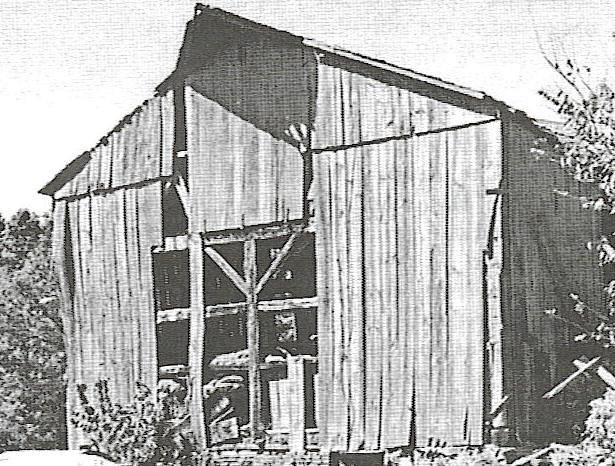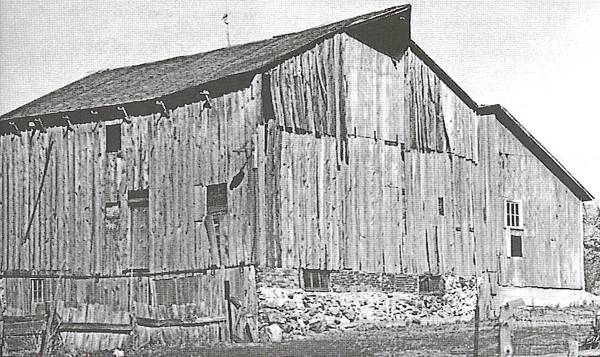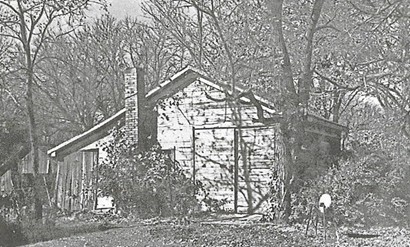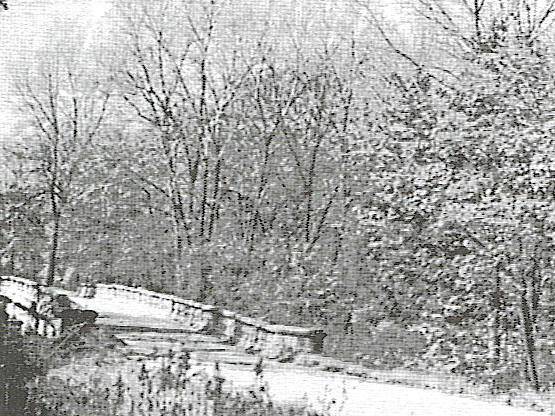
|
Carroll County IAGenWeb |
PHOTO GALLERY Other Pages:
Mrs. Ben (Mary) Pinnekamp and Lois Rowe Brown From: St. Bernard Parish 1880-1980 ________________________________________________________________
Frank Polking Family 1943 Art, Frances, Ray, Frank and Mildred Grace, Larry, Marcell, Edward and Julianna From: St. Bernard Parish 1880-1980 ________________________________________________________________
William Henry Price William Henry Price my second great grandfather was born about 1821 in New York. As a young man he is found living in New York City. Locating him in New York Directories it seems he had a few different jobs, such as painter, car man and working for John Price & Son. William married Harriet Alma Burtis in New York and they had there: Sarah Elizabeth, born about 1846, William Henry Price, Jr. born 19 May 1848, John M. Price, born about 1850, James Greer Price, born 28 Oct 1852. William is next found in Carroll County, Iowa. Their last child Charles W. Price born there in 1860. William seems to have been a manager of a small hotel in Carrollton about 1857, in Carroll County he was Superintendent 1858-1861, County Judge 1861 – 1867, Treasurer 1870-1873 and County Auditor 1870 – 1871. I think he taught school soon after his arrival to Carroll County, but I’m not positive. Harriet Price died 12 June 1865 and is buried in the Old Carrollton Cemetery. William next married Evelina Osgood Bangs Billings 9 November 1871 in Cedar Rapids. It seems William was found to be short in his funds while treasurer/auditor
of about William live out his life in Cedar Rapids, though did some traveling as I found he wrote the city and name of each Minister of the church’s he attended in his bible. He passed away 1 March 1893 in Cedar Rapids and is buried at Oak Hill Cemetery. William’s daughter Sarah married Thomas B. Aldrich 19 September 1861 in Carroll, it seems he was killed in the Civil War and she married second Herbert L. McMann 16 December 1867 in Greene County, Iowa. They moved to New Brunswick, son’s William and James moved to Sacramento, California. William became a large landholder in Vacaville, California and was a Mason, he advanced to Knights Templar and became eminent commander for the term of 1907-8. I don’t know what happen to son John M., and last known residence for Charles W. was in 1880 living and working in the Tefft Hotel with his relative Dr. John J. Burtis who was the proprietor. I have enclosed a bio for William Henry Price. I descend through William's son James Greer Price. If anyone there knows anything more on my family line I would love to hear from them. Thank you.
________________________________________________________________
Anton and Agnes Jasper Pollman From: St. Bernard Parish 1880-1980 ________________________________________________________________
Henry and Margaret Pollman From: St. Bernard Parish 1880-1980 ________________________________________________________________
Frank and Frances Julich Polking From: St. Bernard Parish 1880-1980 ________________________________________________________________
Bernard and Mary Zweifinnig Pinnenkamp From: St. Bernard Parish 1880-1980 ________________________________________________________________
Anton Sr. and Mary Woerdehoff Polking From: St. Bernard Parish 1880-1980 ________________________________________________________________
Frank Pudenz Sr. (Grandparents of Norbert and Laurence) From: Mt. Carmel Centennial 7-16-69 ________________________________________________________________
Double Wedding Theo. and Margaret Spangler Potthoff Peter and Margaret Potthoff Hausman 9-30-1913 Photo from: "1883 Halbur 1983 Memories of Yesterday Dreams of Tomorrow" ______________________________________________________________________
August Prenger Sr. Ann Rolfes, Ann Louise, August Jr. Rose Eich, Clem, Mary Hinners, Joe Photo from: "1883 Halbur 1983 Memories of Yesterday Dreams of Tomorrow" ______________________________________________________________________
Ted Potthoff Sr. Henry, Ted Sr., Mary, Peter Margaret, Ted Jr., Kate Photo from: "1883 Halbur 1983 Memories of Yesterday Dreams of Tomorrow" ______________________________________________________________________
M/M Alvin Potthoff Photo from: "1883 Halbur 1983 Memories of Yesterday Dreams of Tomorrow" ______________________________________________________________________ Wlm Petersohn 1932 Photo from: "1883 Halbur 1983 Memories of Yesterday Dreams of Tomorrow" ______________________________________________________________________
Mary Petersohn Photo from: "1883 Halbur 1983 Memories of Yesterday Dreams of Tomorrow" ______________________________________________________________________
Henry Petersohn Photo from: "1883 Halbur 1983 Memories of Yesterday Dreams of Tomorrow" ______________________________________________________________________ Geo. and Margaret Heiderscheidt Pletchette Photo from: "St. Mary's-Willey Immaculate Conception Church 1882-1982" __________________________________________________________________________
Anton Pille Photo From: "1875-1975 St. John's Catholic Church Arcadia" ______________________________________________________________________________
While growing up in the late 1800s, Iva Frazier (Paup) had a great interest in the history of her family and in the pioneer neighborhood which straddles the Carroll/Greene county line northeast of Glidden. She spent many hours listening to her grandfather, Enos Butrick, whom she called "The Old Settler" tell of the settling of the area. Enos had established the first permanent home in Carroll County after being the second settler in Greene County. Iva Frazier Paup recorded her recollections as well as her own observations in the book "Buffalo Trails Plowed Under," published in 1924 by the Glidden Graphic. Mrs. Paup wrote several short stories, as well, regarding the history of Carroll County. We print two of those stories here, "The Raising of the Lincoln Barn" and a story of her own experience at the "Christmas of 1894." It should be remembered that she wrote these stories 50 years ago, in 1951. Editor X. A. Imel published the stories and pictures in the Glidden Graphic in April 1951. However I believe they tell the story of pioneer life so well they deserve to be included in this more convenient form. In the course of researching this material I found the hand written copy from Mrs. Paup and the stories are reproduced here as she wrote them. Present and future generations owe a great debt to Mrs. Paup, not only for her description of early pioneer living in this area, but also for her recording of the settlement of Carroll County just as the county's first settler, her grandfather, Enos Butrick told it to her. Following are two descriptive short stories of life in Iowa in the late 19th century - just as western Iowa was getting settled. (Remember they were written in 1951)
"Lincoln" Barn Ever so often-especially when old timers gather, folks begin to discuss the early history and the hardships of the pioneers of their native State. Since early childhood the history of my county, Carroll Co. Iowa, has been to me of vital interest, and with much regret do I see the passing of the first pioneers—in fact few if any are left to tell first hand of the joys and hardships of moving in to this vast land of promise.' So we must learn of the early days from the second generation—descendants of those pioneers. Thus was recalled to my mind recently, some early history of the county, when a package was received by me through the mail from a Mr. C. Kilgore of Ralston, Iowa. I hurriedly opened the package—I knew no one by the name of Kilgore -- what could the package contain? A letter attached to the package explained the sender had recently read my pioneer story "Buffalo Trails Plowed Under" published a few years ago by the Editor of the Glidden Graphic, X. A. Lmel, while scouting around Mr. Kilgore had spotted the location of many of the places mentioned in the story-had found them as good picture material-he had sent the finished result to me thinking I would enjoy them. I was thrilled to tears as each picture came to view-The Kendall bridge built in the 1860s, the old Duckett farm from where Katie Butrick first sighted "Heavenly Valley" and where Indian Chief Johnnie Greene and his tribe camped each fall on his annual hunting trip to the north country — a long view of the Salisbury cemetery, the three tall pine trees shading the graves of those first settlers, the trees bought from the first nursery in the little village of Jefferson over in Greene Co., by my uncle Willis Butrick and set out by him in the 90s. Pine trees were not native to Carroll Co., and these one sees over the countryside were "set out." The view of the winding river road past the John Toms and the Lew Chipman farms—my mothers cottage set far back in a grove of native trees. No need of an explanation—I knew the location of each picture as though it were yesterday when, as a child, I followed the old trails by foot or by horse and buggy; the bare grass plot, tall elm trees in the background where once stood the little new grocery store and the blacksmith shop in the town of Benan. Each picture to my mind suggested a pioneer story. As the last two pictures fell from their tissue wrapped package what to my delight were the best of the lot—in a pioneer setting of thick undergrowth and trees was the picture of the lean-to of a house with tall brick chimney, old grind stone by the door under a shade tree, typical of pioneer days— and that house is what now remains of the first frame house built on the spot where Enos Butrick pitched his tent in 1852 establishing the first home in Carroll county, building a log house to shelter his family on what is now known as the Slocum farm. At the time of this story the Kendall family occupied the old farm and it was decided to replace the log house by building a frame house—also a barn to replace the log barn. And so it was that the companion picture taken nearby of the first frame barn to be built in the neighborhood and this barn, so says the "Old Settler," was 'raised' on April-14, 1865-the day Abraham Lincoln was assassinated. Lincoln has been my inspiration ever since my childhood days when the "old settler" would tell me incidents of those war days-how nearly every able bodied man in the county had enlisted, many of them had fallen in battle and many had been wounded; how the big barn was raised one beautiful April morning many years ago.
Christmas Time of Long Ago by Iva Frazier Paup (written in 1951) Memory—has a habit of turning backwards, especially at Christmas time, and as I sit by the glowing fire in the cozy den of our Hollywood home this Sunday afternoon, far from the scenes of my childhood, outside a thick fog, like a roll of soft white cotton, presses against the window pane, fitting down over the house like a snug tea-cozy— and in the dancing embers of the hearth, memories come thick and fast and for an hour we live again the dear days of long ago. It is Christmas eve of the year 1894 and there is much excitement in our little home on the Iowa prairies; there is to be a Christmas tree at the school house across the river and we are all going ~ a tree with lighted candles, gifts for all, singing of songs and speaking of pieces: and last but not least Santa is to be there with a string of sleigh bells around his ample form....such joy. We three children, Katie age three, Johnnie age nine, and myself seven years, were so excited that Mother, glad to be rid of us for a while, bundled us up and sent us out of doors where we might work off some of our excess gayety. A skiff of snow covered the winter landscape and the timber around our cottage stood bare and cold except for a few vivid, red leaves clinging to the stubborn oak trees. For a time we children raced through the wood playing fox-and-geese or tag, and soon the cold, red sun dropped below the prairie rim with two sun-dogs, one on each side...predicting colder weather on the morrow. Suddenly, around the brow of the hill coming along the snow drifted road, we see a sleigh, the steam from the horses nostrils billowing away like wisps of fog. Our sister Frances and her young husband Charlie were in the sleigh, coming to take us to the Christmas program. We raced to the house and soon we were ready for the ride to
the school house. Frances, who was scarcely eighteen, was the most excited of
all the group for, though we children firmly believed in Santa Claus, from the
glow on Frances' cheeks and the The little white one room school house was crowded with folks from the neighborhood when we arrived. The teams hitched to sleighs, spring buggies and wagons were tied to hitching posts around the school yard. A yellow glow shone from the windows and gleamed from the door as we made our way up the cinder path. As we entered the door we gazed with wonder at the pine tree as tall as the ceiling, gaily lighted by vari-colored wax candles and festooned with strings of popcorn, cranberries, and chains of bright colored paper. We made our way to the front seats and sat down by a little neighbor girl, Mary, and there right before us, halfway up on the tree were two dolls exactly alike...two brown haired dolls, the likes of which we had never seen, for we were country children and probably, up to that time had never seen a real Christmas tree much less gay lights and loads of gifts as we were seeing this night...the tree was simply breathtaking...and we looked with longing at the dolls we never even thought that such joy as owning them could be ours. Besides, Mary had just informed us the beautiful doll would, no doubt, be hers. We knew her people were well-to-do farmers while our mother was very poor and in no way could she afford such luxury as bisque dolls for her orphan girls. To the right of the tree another gift attracted our attention...a rocking chair and attached to the chair by a big, red bow was the name of the recipient for Santa to read. Under the tree was a home made sled painted a bright red, a tiny iron cook stove, a pair of high felt boots and pinned to the branches were red mittens and warm hoods. Most people were poor in that farming community and gifts were practical....the most Katie and I expected was maybe a hair ribbon or mittens and perhaps a candy cane for good measure and contented we would be with a striped sack of candy given to each of those attending. At last we heard the sound of sleigh bells and through the door came Santa....a jolly old fellow dressed in a red suit and peaked cap, his face rosy red...twinkling eyes....what a thrill...and we three children held tight to each others hands with excitement as gift after gift was taken from the tree and handed here and there through the audience. At last the beautifully painted red sled was handed to my brother Johnnie to the pure joy of we two girls. And the big "happy hollow" rocker with the red bow was handed over the head of the crowd to our mother. Mary was squirming with excitement so eager was she for the doll she knew would be hers, Katie and I sharing her excitement for just to be near such a prize as she was about to receive would be joy. Then it was that Santa reached up and carefully took the beautiful doll from the tree...we two girls were holding our breath as he turned it around, held it tightly and lovingly in his arms till it said "Mama" in a thin little voice. Santa smiled at the girls in the front row then he seemed to nod with a slight wink toward Mary, he slowly read the name on the tag pinned to the doll—Katie May Frazier" and he stooped low and placed the dainty doll in the arms of the unbelieving and bewildered Katie. Slowly he backed away, turned around and lifted the other doll from the tree and again read the name on the attached card "Iva Frazier." Stooping low and with a flourish Santa placed the doll in my arms. It was unbelievable that the two most beautiful dolls on the tree should be gifts for we two girls. I do not remember what took place around the tree after that. But I do remember riding home in the sleigh, Mother, seated in the rocker, laughing gaily as the, horses drew the sleigh through the snowy woods, swinging around curves and dipping down into frozen creek beds while three happy children held tight to the toys from their first Christmas tree. When we grew older and no longer believed in Santa Claus we learned how Frances and Charlie had skimped and saved to buy the rocker, sled and dolls for Mother and we three children, going early to the school house to place them on the tree... This section on Iva Frazier Paup was taken from: "They made a Difference" by Bill Ferguson Iva's niece still lives today in Lanesboro her descendents are the Leroy Winker Children.
Iva refers to this house in her Christmas story built on the site of the original Enos Butick place where his first cabin stood.
This is the Kendrick Bridge |
______________________________________________________________________







